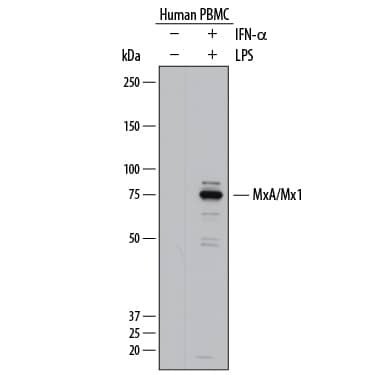Human MxA/Mx1 Antibody
R&D Systems, part of Bio-Techne | Catalog # AF7946

Key Product Details
Validated by
Species Reactivity
Validated:
Cited:
Applications
Validated:
Cited:
Label
Antibody Source
Product Specifications
Immunogen
His412-Leu630
Accession # P20591
Specificity
Clonality
Host
Isotype
Scientific Data Images for Human MxA/Mx1 Antibody
Detection of Human MxA/Mx1 by Western Blot.
Western blot shows lysates of human peripheral blood mononuclear cells (PBMC) untreated (-) or treated (+) overnight with 20 µg/mL Recombinant Human IFN-a Universal Type I (Catalog # 11200-1) and 1 µg/mL LPS. PVDF membrane was probed with 1 µg/mL of Goat Anti-Human MxA/Mx1 Antigen Affinity-purified Polyclonal Antibody (Catalog # AF7946) followed by HRP-conjugated Anti-Goat IgG Secondary Antibody (Catalog # HAF017). A specific band was detected for MxA/Mx1 at approximately 75 kDa (as indicated). This experiment was conducted under reducing conditions and using Immunoblot Buffer Group 1.MxA/Mx1 in Human PBMCs.
MxA/Mx1 was detected in immersion fixed human peripheral blood mononuclear cells (PBMCs) treated with IFN-alpha using Goat Anti-Human MxA/Mx1 Antigen Affinity-purified Polyclonal Antibody (Catalog # AF7946) at 1.7 µg/mL for 3 hours at room temperature. Cells were stained using the NorthernLights™ 557-conjugated Anti-Goat IgG Secondary Antibody (red; Catalog # NL001) and counterstained with DAPI (blue). Specific staining was localized to cytoplasm. View our protocol for Fluorescent ICC Staining of Non-adherent Cells.MxA/Mx1 in Human Thymus.
MxA/Mx1 was detected in immersion fixed paraffin-embedded sections of human thymus using Goat Anti-Human MxA/Mx1 Antigen Affinity-purified Polyclonal Antibody (Catalog # AF7946) at 3 µg/mL overnight at 4 °C. Before incubation with the primary antibody, tissue was subjected to heat-induced epitope retrieval using Antigen Retrieval Reagent-Basic (Catalog # CTS013). Tissue was stained using the Anti-Goat HRP-DAB Cell & Tissue Staining Kit (brown; Catalog # CTS008) and counterstained with hematoxylin (blue). Specific staining was localized to cytoplasm of thymocytes. View our protocol for Chromogenic IHC Staining of Paraffin-embedded Tissue Sections.Applications for Human MxA/Mx1 Antibody
Immunocytochemistry
Sample: Immersion fixed human peripheral blood mononuclear cells (PBMCs) treated with IFN-alpha
Immunohistochemistry
Sample: Immersion fixed paraffin-embedded sections of human thymus
Western Blot
Sample: Human peripheral blood mononuclear cells (PBMC) treated with Recombinant Human IFN‑ alpha Universal Type I (Catalog # 11200-1) and LPS
Formulation, Preparation, and Storage
Purification
Reconstitution
Formulation
Shipping
Stability & Storage
- 12 months from date of receipt, -20 to -70 °C as supplied.
- 1 month, 2 to 8 °C under sterile conditions after reconstitution.
- 6 months, -20 to -70 °C under sterile conditions after reconstitution.
Background: MxA/Mx1
MxA (orthoMyxovirus-resistant protein A; also IFN-induced protein p78/IFI-78K and Mx1) is a 75-78 kDa member of the Dynamin family, GTPase-binding superfamily of proteins. It is induced by type I and III interferons, and is known to reside in the cytoplasm and associate with the membranes of the ER. Typically, IFN-alpha is produced when influenza virus RNA (plus other viral dsDNA and RNA) is detected by internal Pattern recognition receptors (PRRs). IFN-alpha induces the synthesis of 300+ genes, one of which is MxA (Mx1 in mouse). In primates, MxA is cytoplasmic, and interacts with the influenza virus replication cycle at a point proximal to the transcription of genomic RNA into mRNA. By contrast, Mx1 in mouse acts in the nucleus to block primary viral gene transcription. Functionally, MxA is a GTPase, but it is only the binding of GTP to MxA that is associated with antiviral activity. Nucleotide binding to MxA is also associated with nonviral activity, being associated with the potentiation of TRPC Ca2+ channel activity. Human MxA is 662 amino acids (aa) in length. It contains one GTPase domain (aa 69-340) and a GED (GTPase Effector Domain) over aa 574-662. There are two ultilized phosphorylation sites at Tyr129 and Tyr451. MxA forms homo-dimers, -tetramers and -oligomers, with multimerization suggested to be important for activity. Although IFNs are typically considered to induce Mx gene expression, HSV-1 itself also activates gene transcription. In this case, however, a truncated 54-57 kDa transcript is generated that contains an 84 aa substitution for aa 425-662. Over aa 412-630, human MxA shares 49% aa sequence identity with mouse Mx1.
Long Name
Alternate Names
Gene Symbol
UniProt
Additional MxA/Mx1 Products
Product Documents for Human MxA/Mx1 Antibody
Product Specific Notices for Human MxA/Mx1 Antibody
For research use only


